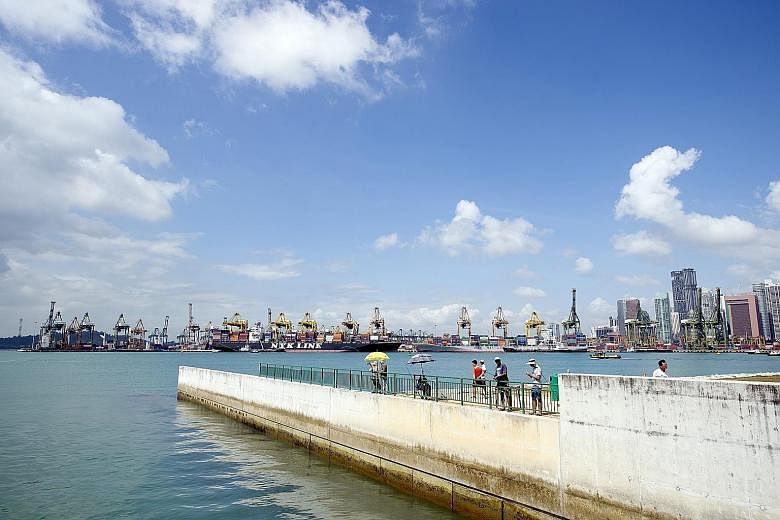Weakening global demand and growing competition are hammering Singapore's ports with overall container throughput plunging in the third quarter.
The number of containers handled tumbled 13 per cent in the three months to Sept 30 compared with the same period last year, said the Ministry of Trade and Industry (MTI).
That underlines the trend seen in the second quarter, when container throughput fell 8.2 per cent, due in part to "weak Asia-Europe trade".
While lacklustre economic conditions are playing a major role, analysts also note that the ports are being squeezed by intensifying competition.
Freight rates are at multi-year lows amid the collapse in commodity prices as well as slowing growth in China and lacklustre demand from the United States, Europe and Japan, noted a separate report by Fitch Ratings on Tuesday.
The Baltic Dry Index, a proxy for global freight prices for raw commodities, touched a record low in April.
Compounding the problem is the severe overcapacity within the industry, added Fitch Ratings.
While global seaborne trade grew 38 per cent in the decade up to last year, vessel capacity soared by a disproportionate 89 per cent.
The capacity glut has prompted some of the world's biggest shipping lines to form alliances.Maersk Line and Mediterranean Shipping - the world's No.1 and No.2 shipping lines respectively - recently formed the 2M Alliance, while CMA CGM, the third-largest, is in a tie-up with China Shipping Container Lines and United Arab Shipping.
Such alliances typically call at select ports and enable carriers to pool resources and reduce costs.
Mr Victor Wai, research analyst at Drewry Maritime Equity Research, noted that Mediterranean Shipping, a major shipping customer of Singapore, reduced its capacity for Asia-North Europe trade after the 2M Alliance was created.
The Ocean Three Alliance, which calls at Port Klang in Kuala Lumpur, has also drawn cargo away from Singapore, he said. Port Klang's transhipment volume jumped 10.6 per cent in the third quarter over the same period last year.
"For the other liners, the favourable exchange rate for transhipping at Malaysia supported the volume shift from Singapore as well," added Mr Wai.
The Port of Tanjung Pelepas in south-western Johor, for instance, saw volume jump 8.8 per cent in the third quarter.
At the same time, the excess ship supply and low fuel costs means these alliances "will look to call at additional gateway ports and reduce their relay transhipment volumes and, accordingly, costs", noted Mr Andy Lane, a partner at CTI Consultancy.
"The oversupply of ship capacity will prevail for several more years and it also seems that a significant rise in fuel costs will not be forthcoming," he said.
Singapore functions as a transhipment hub along the shipping route from Asia to Europe, which means cargoes here are mostly in transit and bound for other destinations.
Shanghai, Shenzhen and Hong Kong, on the other hand, are more gateway ports used for imports and exports.
In 2010, Shanghai overtook Singapore as the world's busiest port.
The gap between the two has widened since but Singapore remains the world's second busiest, handling about 33.6 million standard container units last year.
Singapore is not the only port feeling the heat from softening global trade. Jebel Ali in the United Arab Emirates, which handles significant transhipment activity between Asia and Europe, logged a marginal 0.2 per cent growth during the third quarter - its slowest in two years - compared with a 9.9 per cent spike in the same period last year. Container throughput in Hong Kong fell by 12.8 per cent in October, more than September's 6.7 per cent slide, while China's top eight container ports, which includes Shanghai, handled 1 per cent less cargo that month.
Maersk Line Asia-Pacific chief executive Lars Jensen said that his firm has cut expectations for global container demand this year from 2 to 4 per cent to 1 to 3 per cent, which has had "an impact on the throughput of ports to varying degrees, depending on their locations".
Prospects for the industry, he added, "remain weak".
Meanwhile, Mr Wai believes Singapore continues to face challenges as liners continue to adjust capacity and "the full-year effect of alliance formation is not over".
"Singapore has lost transhipment volume to Port of Tanjung Pelepas, Port Klang and Colombo," he said. "Should Neptune Orient Lines (NOL) be bought over by CMA CGM, which is part of the Ocean Three alliance calling at Port Klang, Singapore is likely to lose more volume."
Mr Wai was referring to NOL's announcement last week that it is in exclusive talks with CMA CGM on a possible buyout.
Mr Lane, however, pointed out that the complexities of shipping alliances - in terms of total volumes and decision-making processes - make it "far less likely that they can or will move remaining transhipment volumes to alternative hubs".
Alliances aside, the possibility of alternative trade routes could pose another hurdle for Singapore, especially if the much-discussed Kra Canal through Thailand, which would allow ships to bypass the Strait of Malacca and Singapore's port hub, materialises.
For now, plans for the canal remain up in the air. Chinese media reported in May that China and Thailand had signed an agreement to build the canal but the Chinese government quickly said later it was not involved in the project.
Home-grown shipping firm Pacific International Lines (PIL) managing director Teo Siong Seng is confident Singapore's ports remain a strong contender globally.
"Alliances are never permanent. But Singapore is still a very important shipping hub for many shipping lines," said Mr Teo, adding that Singapore is PIL's key Asia-Pacific transhipment hub.
"That's why it's important to keep investing in our capabilities, especially in times like these, to continue to consolidate and improve our position while working closely with shippers to remain relevant."
A spokesman from the Maritime and Port Authority of Singapore acknowledged that the headwinds for ports worldwide are "likely to continue for the next few years", while alliances will continue to evolve. "It is important that we maintain our competitive advantage by promoting greater efficiency and higher productivity in order to enhance services to shipping lines in the long-term," he said.
Work to expand container handling capacity and strengthen Singapore's position as the world's largest transhipment hub is already under way.Port operator PSA is expanding the Pasir Panjang Terminal in a $3.5 billion project that will be completed in 2017, while the Government has said that a new mega-port in Tuas will house all container operations from the next decade. Singapore will then be able to handle up to 65 million standard container units annually, up from 40 million units today.


